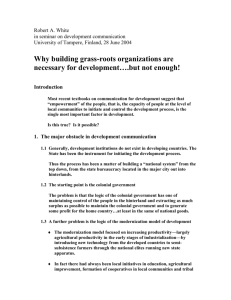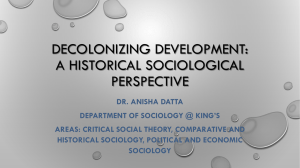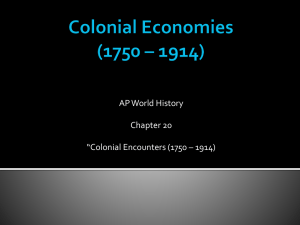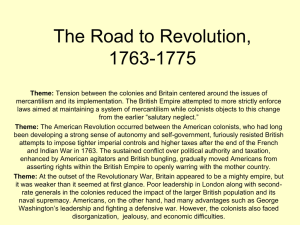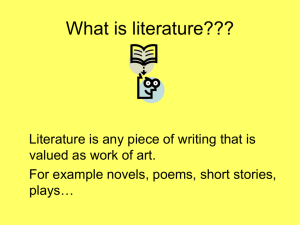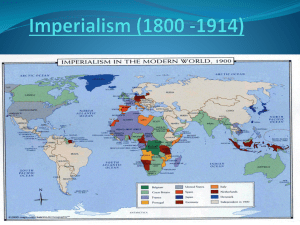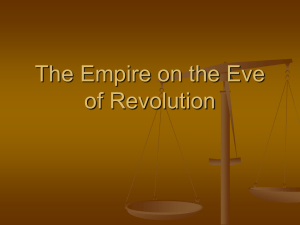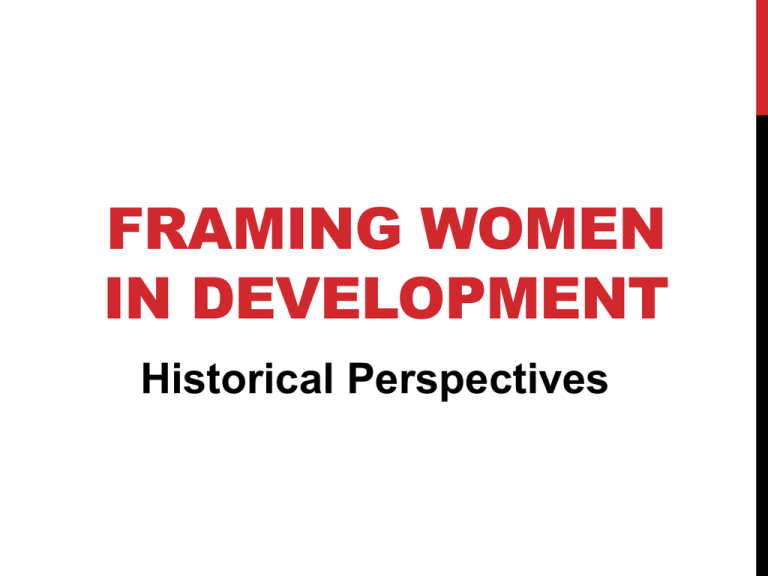
FRAMING WOMEN
IN DEVELOPMENT
Historical Perspectives
OF RIGHTS AND
RESCUE
• ‘Development’ as a 20th century project framed by the
European imperial conquest
• The “3 Cs” – Christianity, Civilization and Commerce created
new opportunities and constraints for women
• Early colonial intervention made women objects of colonial
concern and rescue, but left them out of politics and economic
development: transposition of European gender norms
• Colonial (male) officials’ preoccupation with sexuality: child
marriage, FGM, ‘black peril’, women in towns…
• Efforts focused on producing proper women and model citizens
– education of women to improve hygiene and women’s
domestic capabilities, community development
‘DEVELOPMENT’ =
WITHOUT WOMEN
•
1929 Colonial Development Act about economic development
of the colonies, and aid to ‘countries that have not yet
achieved responsible government
•
Colonial governance between the World Wars focused on
developing indirect rule – completely disregarding women’s
roles in governance
•
Colonial agricultural policies about developing cash crops
for export and extension for male farmers - eclipsing
women’s role in agricultural production
•
Colonial female education about hygiene, domestic science,
transposing European notions of women’s place in the home
•
Colonial community development used as a way to
‘rehabilitate’ rebellious women and put them to good works
W(OMEN) I(N)
D(EVELOPMENT) - WID
• Integrating women into development –
enabling them to gain access to the benefits of
development
• Critique was focused on women’s productive
roles being ignored, and failures of
development to ‘trickle down’ to women
• Focus on women’s education and skills
training that would make them more
productive and improve their access to the
market
THE EMERGENCE OF
‘GENDER’
•
GAD as a feminist project: emerging directly out of second wave
feminism
•
Women (and men) framed by the sex/gender distinction
•
The mantra of ‘gender as the socially constructed relationship
between women and men’
•
Feminist critique of the biases of welfare economics foundational
to GAD
•
Underpinned by a particular framing of women – as hard-done-by,
neglected, virtuous, subordinated, situated in a very particular
version of ‘gender relations’
•
The (unspoken) hegemony of the gender binary: ‘gender relations’
become a particular kind of relationship between women and
men…
FROM ‘GENDER’
TO ‘WOMEN’S
EMPOWERMENT’
• ‘gender equality’ had been the clarion call of the 1990s –
spurred by being taken up and promoted in the wake of Beijing
• ‘women’s empowerment’, brought to Beijing by southern
activists, had begun to be domesticated by the early 2000s
• By the mid-2000s, GEWE had gained some purchase as an
acronym; by late 2000s, ‘gender equality’ was fast going out of
fashion…
GENDER MYTHS AND
FEMINIST FABLES
Feminist researchers contributed to a large body of work in which
women were made visible to development, and out of which the
following myths surfaced:
• Women are less corrupt than men
• Women work harder than men
• Women are not only less violent but want peace more than
men: women are the peace-makers
• Women are closer to nature and the earth
• Women care more for their children than do men
• Sex work is the last resort for women, who are pushed into it
by desperate poverty
• Women will take care of their households if they get money,
rather than spend it on their own pleasure
REPRESENTING
WOMEN
The victim
• Images of abjection: women and girls as the poorest of the
poor, abused by men, denied opportunities, in need of
empowerment – objects of rescue
The heroine
• Images of women and girls as ‘agents of change’, able to ‘lift
economies’, families, communities
THE VICTIM PARADIGM
• as victims, lacking power, women become objects of
rescue and subjects of development intervention.
• This gives development agencies a sense of moral
authority that they use to legitimate themselves as rescuers
• “bodily integrity” becomes a way to assert and protect
women’s virtue – and an umbrella for a host of other
agendas
• this precludes recognition of women’s sexual agency, of
sexualities beyond GAD’s heteronormative assumptions of
victimised heterosexual women, of pleasure…
THE EMPOWERED
WOMAN
• Women are industrious, they are survivors, they juggle triple
burdens, raise economies and sustain communities;
• Women framed as morally superior to men, a better object for
investment that can generate returns: ‘educate a woman and
you educate a nation’
• Women as ‘agents of change’ are women as economic and
political actors in the public sphere: sexuality & the private
sphere falls out of the frame
• Women and girls as an ‘investment’- a magic bullet that can be
used to tackle just about any problem
• Women appear in empowerment narratives unencumbered by
‘gender relations’
THE ‘NEW WOMAN CITIZEN’
“The neo-liberal rules for the new woman citizen... are quite
clear: improve your household’s economic condition,
participate in local community development (if you have time),
help build and run local (apolitical) institutions like the selfhelp group; by then, you should have no political or physical
energy left to challenge this paradigm.”
Srilatha Batliwala and Deepa Dhanraj (2004:13) in “Gender myths that
instrumentalise women: a view from the Indian front-line.”
MISSING MEN
• Men appear in two domains of GAD discourse:
violence and HIV – they (and research/activism on
masculinities) are absent from policy debates on
economic empowerment and on gender & politics
• Men-in-general are represented as hazardous and
useless: men are violent, men infect women with
HIV, men drink away women’s money, men don’t
look after their families – women and girls are
represented as a better investment
EM-POWER-MENT
• EmPOWERment has become “em-ment”
• Neoliberal empowerment less about transforming
gendered power relations than equipping women for
the market and enlisting them as consumers as well
as producers
• Power becomes something that can be given or
bestowed, something men have in excess and that
women are lacking
• All other forms and dimensions of power fall away,
out of view: women become the deserving objects of
development assistance, and men are a ‘waste of
rations’
CONTINUITIES, CONTRADICTIONS
AND SILENCES
• Echoes of colonial concerns with protecting women’s virtue –
exemplified in anti-trafficking/prostitution narrative and the
rescue industry. Women’s (active, positive) sexuality falls out of
the frame
• Mirror image of colonial disregard of women’s role in economy
and governance – very little programming or policy discourse
now pays any attention to the fragility of employment prospects
for men living in poverty and the absence of opportunities for
them
• “Gender” seems to have completely disappeared….
REFRAMING WOMEN IN
DEVELOPMENT: TOWARDS A
NEW NARRATIVE
• Re-positioning POWER – reclaiming a more structural
perspective, making visible the power effects of difference and
reclaiming resistance
• Re-framing DEVELOPMENT – beyond planned intervention
and an obsession with ‘policy’
• Re-articulating GENDER – beyond limiting binaries and
pervasive heteronormativity
• Re-imagining ASSISTANCE – from ‘helping’ to acts of
solidarity and resistance
TOWARDS NEW FRAMINGS OF
WOMEN IN DEVELOPMENT
Save us from Saviours!
http://vimeo.com/15137630


